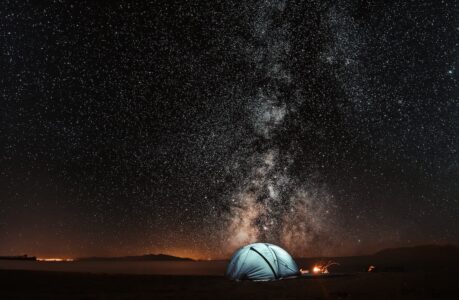The Galaxy Season is a special time of the year when the night sky puts on a magnificent display of celestial wonders. This astronomical event is a showcase of the beauty of our galaxy, the Milky Way, and beyond. During this season, the night sky is illuminated with the light of thousands of stars, distant galaxies, and other cosmic objects that are visible to the naked eye.
The Galaxy Season typically runs from late February to early May, although the exact dates may vary depending on your location and the time of year. During this period, the Milky Way is visible in the night sky, stretching from the horizon to the zenith, and displaying its most spectacular features.
One of the highlights of the Galaxy Season is the presence of the Zodiacal Light, a faint glow that appears as a cone of light stretching from the horizon towards the Milky Way. This ethereal light is caused by sunlight reflecting off interplanetary dust particles, and is most visible before dawn or after sunset, in areas with low light pollution.
Another breathtaking feature of the Galaxy Season is the appearance of the Pleiades, a group of seven bright stars that are visible to the naked eye. This star cluster, also known as the Seven Sisters, is located in the constellation of Taurus, and is a popular target for amateur astronomers and stargazers.
As the night sky gets darker, the Milky Way begins to reveal its stunning features, including the bright band of stars that form its core. The Milky Way’s central bulge is home to some of the most spectacular objects in the galaxy, including star clusters, nebulas, and black holes.
One of the most iconic nebulas in the Milky Way is the Orion Nebula, a massive cloud of gas and dust that is located in the constellation of Orion. This nebula is visible to the naked eye as a fuzzy patch of light, but it truly comes alive when viewed through a telescope, revealing intricate details and vivid colors.
The Milky Way also contains many other stunning nebulas, such as the Lagoon Nebula, the Trifid Nebula, and the Eagle Nebula, each displaying their own unique features and characteristics.
Aside from the Milky Way, the Galaxy Season also offers the opportunity to observe other galaxies in our local group, such as the Andromeda Galaxy and the Triangulum Galaxy. These galaxies are visible as faint patches of light in the night sky, but their beauty and magnitude are truly awe-inspiring when viewed through a telescope.
The Galaxy Season is also a great time to observe meteor showers, as several occur during this period. The Lyrids, Eta Aquarids, and Delta Aquarids are some of the most well-known meteor showers that occur during the Galaxy Season, offering the chance to witness shooting stars streaking across the night sky.
Why is it called Galaxy season
The term “Galaxy Season” refers to the period of the year when the Milky Way galaxy is most visible in the night sky. During this time, the Earth’s orientation in its orbit allows for a better view of the galactic center, which is home to many of the most spectacular features of our galaxy, including star clusters, nebulas, and black holes. The term “Galaxy Season” is used to highlight the abundance of celestial objects that are visible in the night sky during this period, making it a prime time for stargazing and astronomical observation.
Galaxy season occurs in the spring and early summer months of the Northern Hemisphere, usually starting in late February and running through early May. During this time, the Milky Way is visible in the night sky and appears as a band of light stretching from the horizon to the zenith. The term “Galaxy Season” is also used to distinguish this period from other times of the year when the Milky Way is not as visible or prominent in the night sky.
The visibility of the Milky Way during Galaxy Season is due to the Earth’s position in its orbit around the Sun. As the Earth orbits the Sun, it moves through different parts of the Milky Way, and during the spring and early summer months, it is positioned in such a way that the galactic center is visible in the night sky. This alignment provides a clearer view of the Milky Way’s central bulge, which is home to many of the most visually stunning features of our galaxy.
Galaxy Season is particularly important for astronomers and astrophotographers who seek to capture images of the Milky Way and other celestial objects. During this time, the night sky is darker and clearer, providing optimal conditions for observing and photographing distant galaxies, nebulas, and other cosmic objects. The clearer skies also make it easier to see and capture the delicate details and colors of these celestial wonders.
In addition to the Milky Way, Galaxy Season also offers the opportunity to observe other galaxies in our local group, such as the Andromeda Galaxy and the Triangulum Galaxy. These galaxies are visible as faint patches of light in the night sky and are best observed during Galaxy Season.
Key astrophotography targets during Galaxy season
Galaxy season is a prime time for astrophotography, with many stunning celestial objects visible in the night sky. Here are some of the key astrophotography targets during Galaxy season:
- The Milky Way: The Milky Way is the most prominent target for astrophotography during Galaxy season. Capturing the core of the Milky Way is a popular and breathtaking shot, with the bright band of stars and colorful nebulas making for a stunning image. Astrophotographers typically use wide-angle lenses to capture the vast expanse of the Milky Way.
- Orion Nebula: The Orion Nebula is one of the most iconic nebulas in the Milky Way, and is a popular target for astrophotographers. With its intricate details and vivid colors, capturing the Orion Nebula requires a longer exposure time and a telescope or telephoto lens.
- Andromeda Galaxy: The Andromeda Galaxy is the closest galaxy to our own and is visible as a faint, fuzzy patch in the night sky. Capturing the Andromeda Galaxy requires a longer exposure time and a telephoto lens or telescope.
- Lagoon Nebula: The Lagoon Nebula is a bright and colorful nebula located in the constellation Sagittarius. It is a popular target for astrophotography, with its intricate details and vivid colors making for a stunning image.
- Triangulum Galaxy: The Triangulum Galaxy is another popular target for astrophotographers during Galaxy season. With its bright core and intricate details, capturing the Triangulum Galaxy requires a longer exposure time and a telephoto lens or telescope.
- Pleiades star cluster: The Pleiades star cluster is a group of seven bright stars that are visible to the naked eye. Capturing the Pleiades requires a wider field of view and a shorter exposure time, making it a great target for wide-angle lenses.
- Zodiacal Light: The Zodiacal Light is a faint glow that appears as a cone of light stretching from the horizon towards the Milky Way. Capturing the Zodiacal Light requires a longer exposure time and a wide-angle lens.

